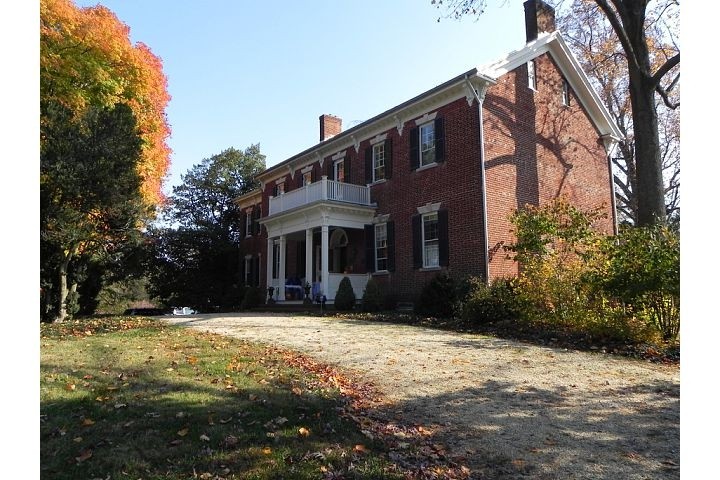Salona and the Langley Tract
Introduction
Text-to-speech Audio
Images
An image of the Salona (McLean, Virginia) field from the frontage on Dolly Madison Rd.

Salona homestead by Ronald J. Baumgarten, Jr.

Backstory and Context
Text-to-speech Audio
Thomas Lee (1690-1750) acquired over 2800 acres of land known as “Langley Tract” in 1719, and his descendants resided there for many years. One such owner was Revolutionary War leader Major-General Henry “Light Horse Harry” Lee III, who eventually served as the Virginia governor and a congressman and who was the father of Confederate general Robert E. Lee. The brick house at the Salona property was built between 1790 and 1810; a plaque placed in 1970 estimates the year as 1802. Rising two and a half stories, the house exhibits characteristics of the Federal and Georgian styles. During the August 1814 British bombardment of Washington, D. C. in the War of 1812, President James Madison and First Lady Dolley Madison sought refuge at this house from its then-resident, Rev. William Maffitt. They escaped separately, with President Madison staying a night at Salona and Mrs. Madison staying at nearby Rokeby before they reunited farther west.
Rev. Maffitt died in 1823, and Chapman Lee of Connecticut purchased Salona, later selling it to Elisha Sherman. James G. Smoot purchased 208 acres of the land from the Salona estate in 1845. The Union Army established a headquarters at Salona under General William “Baldy” Smith, calling it Camp Griffin, in the winter of 1861-1862. The Smoot family fled the property with their slaves. General George McLellan may also have used the camp. After the war, Smoot and his son William worked to restore the farm, seeking reimbursement from the U. S. government for damages to the property during the war. This reimbursement was denied when it became known that Smoot had signed the Ordinance of Secession in 1861.
In commemoration of the bicentennial of George Washington’s birthday in 1932, Salona opened for a public viewing. The Works Progress Administration (WPA) documented the house a few years later in 1936, with a report by H. C. McMullan and aerial photographs showing the late nineteenth-century agricultural buildings.
The Carper family leased Salone for pasture after World War II, and portions of the land were sold for residential development and to two churches. An antiques dealer and McLean Summer Theatre also occupied the building for some time, the latter leaving it in dilapidated condition. Clive and Susan DuVal bought the Salona house and its remaining 52 acres in stages from the heirs of Calder Gillian Smoot in the late 1940s and early 1950s. The DuVals maintained and made improvements to the property, such as moving the driveway from Dolley Madison Highway to Buchanan Road. Woodland began to take over the agricultural fields. The DuVals also added a tennis court to the property, and in 1971 placed a conservation easement on some of the property. Their heirs added another easement to protect an additional 41.5 acres in 2005.
The house remains private property, though the National Register of Historic Places listed it in 1973. The Fairfax County History Commission placed a historical marker at the site in 2010. The Fairfax County Park Authority established a task force and has sought to develop plans to develop a park at the site.
Sources
Baumgarten, Ronald J.. Tenting Tonight on the Old Campground: Present-Day McLean During the Civil War, Part II , All Not So Quiet Along the Potomac: The Civil War in Northern Virginia & Beyond. June 29th 2010. Accessed December 2nd 2019. http://dclawyeronthecivilwar.blogspot.com/2010/06/tenting-tonight-on-old-campground.html.
Baumgarten Jr., Ronald J. Salona Historical Marker, Historical Marker Database. June 16th 2016. Accessed December 2nd 2019. https://www.hmdb.org/marker.asp?marker=65488.
County of Fairfax County Virginia. Salona, Accessed December 2nd 2019. https://www.fairfaxcounty.gov/planning-development/sites/planning-development/files/assets/documents/historic/nationalregister/salona.pdf.
O'Day, James. Salona, 2016 HALS Challenge Entry: Documenting National Register Listed Landscapes. January 1st 2016. Accessed December 2nd 2019. http://cdn.loc.gov/master/pnp/habshaer/va/va2200/va2276/data/va2276data.pdf.
Mckaysalisbury on Wikimedia Commons (https://en.wikipedia.org/wiki/Salona_(McLean,_Virginia)#/media/File:Salona,_McLean,_Virginia.jpg) - CC BY-SA 3.0 (https://creativecommons.org/licenses/by-sa/3.0/)
https://www.hmdb.org/PhotoFullSize.asp?PhotoID=134321
